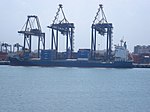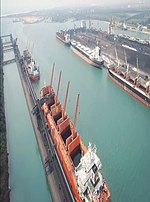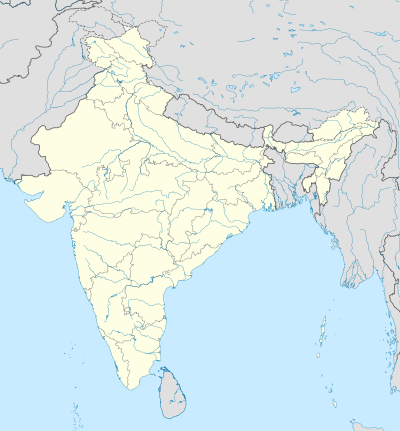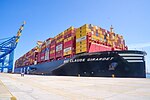List of ports in India
 From Wikipedia - Reading time: 11 min
From Wikipedia - Reading time: 11 min

In India, ports are categorised into major ports and non-major ports (minor ports). As of 2024, the country has 13 major ports[1] and 217 non-major ports. Major ports are administered by the Ministry of Ports, Shipping and Waterways under the Government of India, whereas non-major ports fall under the jurisdiction of State Maritime Boards of respective state governments, including private ports operating under the public–private partnership (PPP) model. Among the 217 non-major ports, cargo is handled only at 68 ports, others are used by fishing vessels and ferries.[2]
India has a coastline of 11,098 kilometres[3], forming one of the largest peninsulas in the world. According to the Ministry of Ports, Shipping and Waterways, around 95 percent of India's trading by volume and 70 percent by value is done through maritime transport. India's major ports handled highest ever cargo of 795 million tonne in FY23.[4]
In 2024, the upcoming International Container Transshipment Port, Galathea Bay was notified as India's 13th major port. However, its first phase of development is expected to be commissioned only in 2028.[1] Port Blair which was notified as major port in 2010 was removed later. The ports are spread across Andaman and Nicobar Islands, Andhra Pradesh, Goa, Gujarat, Karnataka, Kerala, Maharashtra, Odisha, Puducherry, Tamil Nadu, and West Bengal.[5] Government of India plans to build new greenfield ports and also built associated infrastructure such as railway lines through the 2015 established Sagar Mala project,[6] and National Maritime Development Program.[7]
Classification of ports
[edit]According to Constitution of India, maritime transport is to be administered by both the Central and the State governments. While the central government's shipping ministry administers the major ports, the minor and intermediate ports are administered by the relevant departments or ministries in the nine coastal states of Andhra Pradesh, Goa, Gujarat, Karnataka, Kerala, Maharashtra, Odisha, Tamil Nadu and West Bengal. Several of these 187 minor and intermediate ports have been identified by the respective governments to be developed, in a phased manner, a good proportion of them involving public–private partnership.
The maritime boards of state governments administer control of minor ports owned by state governments. In 2018–19, minor ports of Gujarat alone handled total 542 MMT of cargo.[8] Maharashtra Maritime Board sets record of handling 71 mn tons of cargo in 2022–23.[9]
Capacity
[edit]The capacity of Indian ports currently stands at 2,604.99 mtpa.[10] The container throughput of Indian ports stood at 17 million TEUs for the period 2020.[11]
Ship building
[edit]
India has been building large ships after the independence using public sector companies like Garden Reach Shipbuilders & Engineers estb in 1884, Mazagon Dock Shipbuilders, Hindustan Shipyard, Goa Shipyard and Cochin Shipyard. SS Jala Usha, a steamship built by Hindustan Shipyard in 1948 and the first of its kind to be built within the Indian subcontinent after WW-II.The first oil tanker built by Cochin Shipyard Limited (CSL) was the MV Rani Padmini, which was delivered in July 1981.[12] India launched 93,000 DWT oil tanker in 2002 under Third Vajpayee ministry, The ship named Maharshi Parashuram built by Cochin Shipyard was 237 meter long double vessel was fitted with 14,300 HP engine.[13] Abul Kalam Azad is another similar-size oil tanker ship built by Cochin Shipyard in 1999 which has been scrapped.[14]
Ship breaking
[edit]
As of January 2020[update], India has 30% share of ship breaking with annual US$1.1 billion revenue. India is a signatory to Hong Kong International Convention for the safe and environmentally sound recycling of ships. India plans to pass the "Recycling of Ships Act, 2019" to ratify the Hong Kong treaty. This will allow India to capture its targeted 60% in the global ship breaking business while doubling the annual to US$2.3 billion target.[15] India's Alang-Sosiya Ship Breaking Yard is world's largest ships' graveyard.[15] Other ship graveyards in India is the Steel Industrials Kerala Limited breaking unit.[16]
Major ports
[edit]The port's under central Government of india are known as Major port and other ports in India are classified as minor ports.The following are the major ports of India:[17][18]
| No. | Name | Estb. Year | Image | Area(km^2) | Location | State/UT | Cargo handled in MTPA (FY2022-23) |
|---|---|---|---|---|---|---|---|
| 1 | Chennai Port | 1881 | 
|
Chennai | Tamil Nadu | 136 | |
| 2 | Cochin Port | 1928 | 
|
Kochi | Kerala | 79.9 | |
| 3 | Deendayal Port | 1965 | 
|
900.83km2[19] | Kandla | Gujarat | 269.1 |
| 4 | Jawaharlal Nehru Port | 1988 | 
|
33.7 km2 | Navi Mumbai | Maharashtra | 141.37 |
| 5 | Mormugao Port | 1985 | Mormugao | Goa | 63.4 | ||
| 6 | Mumbai Port | 1873 | 
|
Mumbai | Maharashtra | 84 | |
| 7 | New Mangalore Port | 1974 | 
|
8.22 km2 | Mangaluru | Karnataka | 114.96 |
| 8 | Paradip Port | 1966 | 
|
25.44 km2 | Paradeep | Odisha | 289.75 |
| 9 | Syama Prasad Mookerjee Port | 1870 | 
|
Kolkata/Haldia | West Bengal | 92.77 | |
| 10 | Visakhapatnam Port | 1933 | 
|
Visakhapatnam | Andhra Pradesh | 143.68 | |
| 11 | V. O. Chidambaranar Port | 1974 | 
|
2.428 km2 | Thoothukkudi | Tamil Nadu | 111.46 |
| 12 | Kamarajar Port | 2001 | Ennore | Tamil Nadu | 91 | ||
| 13 | International Container Transshipment Port, Galathea Bay[1] | 2028 | Galathea Bay | Andaman and Nicobar Islands |
Private ports
[edit]Unranked ports
[edit]- Angré Port
- New Bedi Port
- Bhavnagar Port
- Farakka Port
- Gangolli Port
- Jakhau Port
- Karanja Port
- Karwar Port
- Kollam Port
- Mandvi Port and Shipyard
- Nagapattinam Port
- Magdalla Port
- Navlakhi Port
- Okha Port
- Port Blair Port
- Porbandar Port
- Rajula Port
- Redi Port
- Rewas Port
- Vadinar Port
- Sikka Port
- Simar Port
See also
[edit]- Gujarat Maritime Board
- Maharashtra Maritime Board
- Karnataka Maritime Board
- Kerala Maritime Board
- Naval Base Karwar
References
[edit]- ^ a b c Simhan, T. E. Raja (20 October 2024). "Galathea Bay: New major port can be game changer". Business Line. Retrieved 10 December 2024.
- ^ "Financial Assistance of approx of about Rs. 1891 crore released under Sagarmala schemes, 151 projects sanctioned till date". Pib.gov.in. 20 December 2022. Retrieved 10 May 2024.
- ^ https://timesofindia.indiatimes.com/india/mha-indias-recalculated-coastline-up-48-in-53-years/articleshow/116927468.cms
- ^ "India's Major Ports Handled Highest Ever Cargo Of 795 Million Tonne In FY23: Sarbananda Sonowal". Outlook. Press Trust of India. 28 April 2023.
- ^ "MoS, GoI". Archived from the original on 5 February 2016. Retrieved 26 March 2019.
{{cite web}}: CS1 maint: bot: original URL status unknown (link) - ^ "Cabinet gives 'in principle' nod to concept of Sagarmala project". Economic Times, Times of India. 27 March 2015. Archived from the original on 2 April 2015. Retrieved 4 July 2015.
- ^ "National Maritime Development Programme". Press Information Bureau, Government of India. 17 December 2015. Retrieved 3 February 2022.
- ^ Media, Gateway (5 April 2019). "GMB ports handle 400 mmt of cargo in 2018-19". Maritime Gateway. Retrieved 15 August 2020.
- ^ "Maharashtra Maritime Board sets record of handling 71 mn tons of cargo in 2022-23 - ET Infra".
- ^ Rajan, Jessica (28 July 2023). "Cargo handling capacity of ports to rise in 2024". The Economic Times.
- ^ "Maritime India Vision (MIV) 2030 estimates investments of Rs. 1,00,000–1,25,000 crore for capacity augmentation and development of world-class infrastructure at Indian Ports".
- ^ "Sailing successfully through a sea of change". The Hindu. 13 August 2013. ISSN 0971-751X. Retrieved 8 November 2024.
- ^ "India's biggest oil tanker to be launched today". The Times of India. 22 January 2002. ISSN 0971-8257. Retrieved 8 November 2024.
- ^ Rowles, Grant (1 January 2018). "Shipping Corporation of India sends ageing tanker for scrap". Splash247. Retrieved 8 November 2024.
- ^ a b India eyes 60 per cent share of global ship recycling business; higher GDP contribution, Economic Times, 30 December 2019.
- ^ Sucheth, P R (26 May 2014). "Locals up in Arms against SILK Ship-breaking Unit". The New Indian Express. Retrieved 3 February 2022.
- ^ "Cargo handling capacity of Major Ports of the country has gone up to 1617.39 Million Tonnes Per Annum (MTPA) as on March 2023". Pib.gov.in. Retrieved 10 May 2024.
- ^ "Operational Details". Indian Ports Association. Retrieved 17 December 2014.
- ^ https://sagarmala.gov.in/sites/default/files/5.Final_Master_Plan_Kandla.pdf [bare URL PDF]
- ^ "Union Cabinet decision: Kutch to get 2 new port terminals at Rs 5,963 crore". 13 October 2022.
 KSF
KSF








